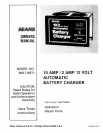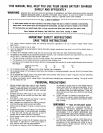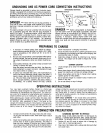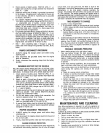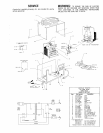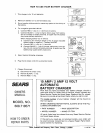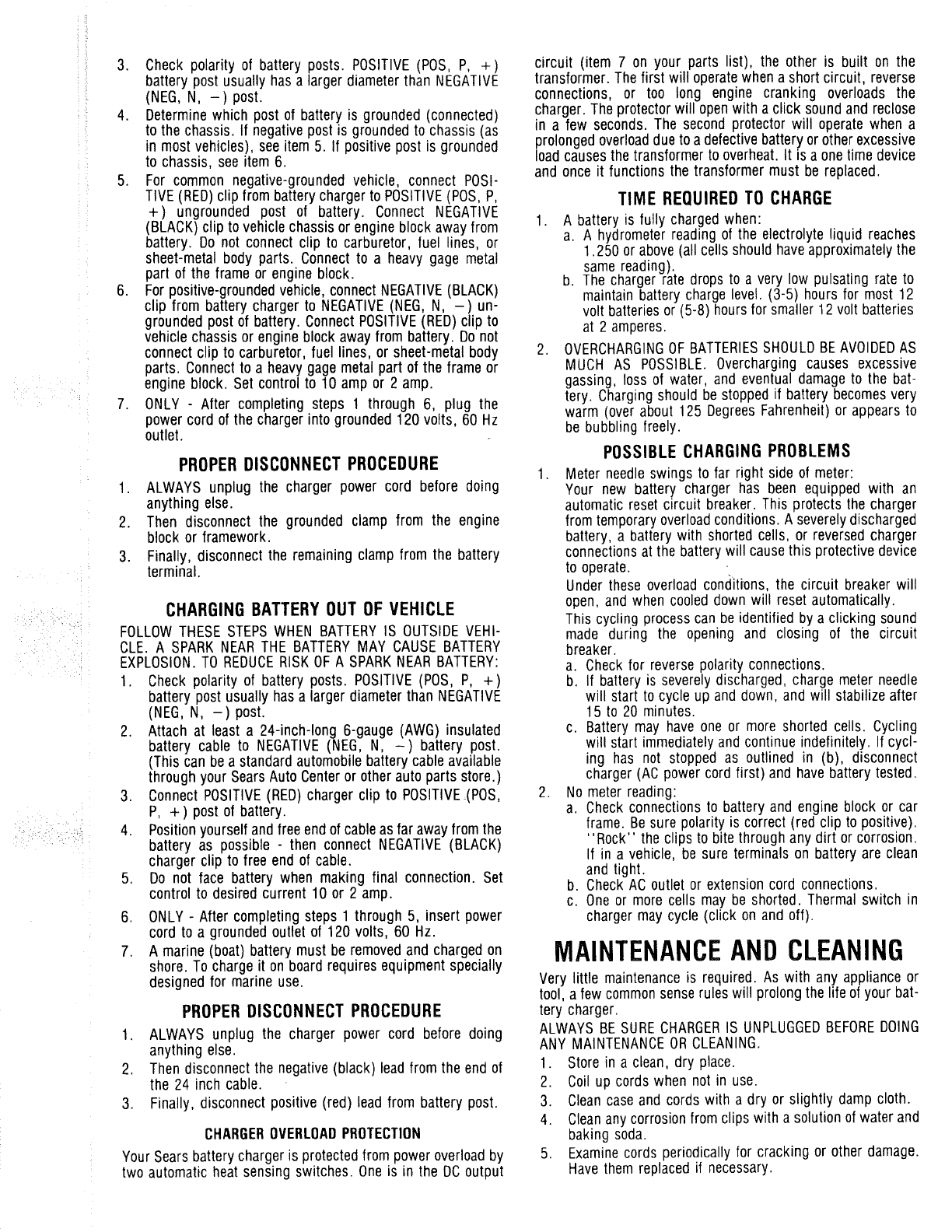
k ¸
3. Check polarity of battery posts. POSITIVE(POS, P, +)
battery post usually hasa larger diameterthan NEGATIVE
(NEG, N, -) post.
4. Determinewhich post of battery is grounded (connected)
to the chassis, tf negative post is grounded to chassis (as
in most vehicles), see item 5. If positive post is grounded
to chassis, see item 6.
5. For common negative-grounded vehicle, connect POS!-
TIVE(RED)clip from batterychargerto POSITIVE(POS,P,
+) ungrounded post of battery. Connect NEGATIVE
(BLACK)clip to vehicle chassisor engineblock awayfrom
battery. Do not connect clip to carburetor, fuel lines, or
sheet-metal body parts. Connect to a heavy gage metal
part of the frame or engine block.
6. Forpositive-groundedvehicle,connect NEGATIVE(BLACK)
clip from battery charger to NEGATIVE(NEG, N, -) un-
grounded post of battery. Connect POSITIVE(RED)clip to
vehicle chassis or engine block away from battery. Do not
connectclip to carburetor, fuel lines, or sheet-metalbody
parts. Connectto a heavygage metal part of the frame or
engine block. Set control to 10 amp or 2 amp.
7. ONLY - After completing steps 1 through 6, plug the
power cord of the charger into grounded 120 volts, 60 Hz
outlet.
PROPERDISCONNECTPROCEDURE
1. ALWAYS unplug the charger power cord before doing
anything else.
2. Then disconnect the grounded clamp from the engine
block or framework.
3. Finally, disconnect the remaining clamp from the battery
terminal.
CHARGINGBATTERYOUT OF VEHICLE
FOLLOWTHESESTEPSWHEN BATTERYIS OUTSIDEVEHI-
CLE. A SPARK NEARTHE BATTERYMAY CAUSE BATTERY
EXPLOSION.TO REDUCERISKOFA SPARKNEARBATTERY:
1. Check polarity of battery posts. POSITIVE(POS, P, +)
battery post usually has a larger diameter than NEGATIVE
(NEG, N, -) post.
2. Attach at least a 24-inch-long 6-gauge (AWG) insulated
battery cable to NEGATIVE(NEG, N, -) battery post.
(This can bea standardautomobilebattery cableavailable
through your SearsAuto Centeror other auto parts store.)
3. ConnectPOSITIVE(RED)charger clip to POSITIVE:(POS,
P, +) post of battery.
4. Positionyourself and freeend ofcable asfar awayfrom the
battery as possible - then connect NEGATIVE(BLACK)
charger clip to free end of cable.
5. Do not face battery when making final connection. Set
control to desired current 10 or 2 amp.
6. ONLY- After completing steps 1 through 5, insert power
cord to a grounded outlet of 120 volts, 60 Hz.
7. A marine (boat) batterymust be removedand charged on
shore. To charge it on boardrequires equipment specially
designed for marine use.
PROPERDISCONNECTPROCEDURE
1. ALWAYS unplug the charger power cord before doing
anything else.
2. Thendisconnect the negative(black) lead from the end of
the 24 inch cable.
3. Finally, disconnect positive (red) lead from battery post.
CHARGEROVERLOADPROTECTION
Your Searsbatterychargeris protected from power overloadby
two automatic heat sensing switches. One is in the DCoutput
circuit (item 7 on your parts list), the other is built on the
transformer. Thefirst will operatewhen a short circuit, reverse
connections, or too long engine cranking overloads the
charger. The protectorwill openwith a click soundand reclose
in a few seconds. The second protector will operate when a
prolongedoverloadduetoa defectivebatteryor otherexcessive
loadcausesthe transformer to overheat. It is a onetime device
and once it functions the transformer must be replaced.
TIME REQUIREDTO CHARGE
1. A battery is fully charged when:
a. A hydrometer readingof the electrolyte liquid reaches
1.250 or above(all cells should haveapproximatelythe
same reading).
b. The charger rate drops to a very low pulsating rate to
maintain batterycharge level. (3-5) hoursfor most 12
volt batteriesor (5-8) hoursfor smaller 12 volt batteries
at 2 amperes.
2. OVERCHARGINGOFBATTERIESSHOULDBEAVOIDEDAS
MUCH AS POSSIBLE. Overcharging causes excessive
gassing, loss of water, and eventual damageto the bat-
tery. Chargingshould be stopped if battery becomesvery
warm (over about 125 DegreesFahrenheit)or appears to
be bubbling freely.
POSSIBLECHARGINGPROBLEMS
1. Meter needle swings to far right side of meter:
Your new battery charger has been equipped with an
automatic reset circuit breaker. This protects the charger
from temporaryoverloadconditions. A severelydischarged
battery, a battery with shorted cells, or reversed charger
connectionsat the batterywill causethis protectivedevice
to operate.
Under these overloadconclitions, the circuit breaker will
open, and when cooled down will reset automatically.
This cycling processcan be identified bya clicking sound
made during the opening and closing of the circuit
breaker.
a. Check for reverse polarity connections.
b. If battery is severelydischarged, charge meter needle
will start to cycle up and down, and will stabilizeafter
15 to 20 minutes.
c. Battery may have one or more shorted cells. Cycling
will start immediatelyand continue indefinitely. If cycl-
ing has not stopped as outlined in (b), disconnect
charger (ACpower cord first) and have battery tested.
2. No meter reading:
a. Checkconnections to battery and engine block or car
frame. Be sure polarity is correct (red clip to positive).
"Rock" the clips to bitethrough any dirt or corrosion.
If in a vehicle, be sure terminals on battery are clean
and tight.
b. CheckAC outlet or extension cord connections.
c. Oneor more cells may be shorted. Thermal switch in
charger may cycle (click on and off).
MAINTENANCEAND CLEANING
Very little maintenanceis required. As with any appliance or
tool, a few commonsenseruleswill prolongthe life ofyour bat-
tery charger.
ALWAYSBE SURECHARGERIS UNPLUGGEDBEFOREDOING
ANY MAINTENANCEORCLEANING.
1. Store in a clean, dry place.
2. Coil up cords when not in use.
3. Cleancaseand cords with a dry or slightly damp cloth.
4. Cleananycorrosion fromclips with a solution of water and
baking soda.
5. Examinecords periodically for cracking or other damage.
Have them replaced if necessary.



